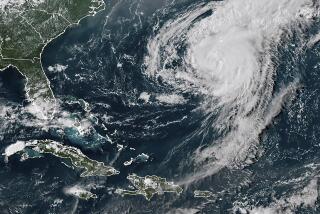Super storm Sandy — an incomparable storm — is over: Some facts
- Share via
Super storm Sandy is over. It’s time to consign to history books a storm that reached 900 miles wide, carried winds speeds of more than 90 mph, caused billions of dollars in damage and claimed at least 55 lives.
“Thirty, 40, 50 years from now, people will be talking about Sandy,” predicted meteorologist Eric Leister in an interview with The Times on Wednesday morning. There are a few infamous storms over the generations, he said, “For this generation, it’s likely that Sandy will be that one that people will always be talking about.”
The storm is drawing comparisons in the media to other huge East Coast storms from the past -- including the 1938 storm dubbed the Long Island Express. A 2010 New York Times article recalled “the corpses floating down Main Street ... the boats that drifted into the living rooms of flooded houses.” That storm devastated Long Island, killing 50 people there among a total of more than 600.
But AccuWeather meteorologist Leister said that, where Sandy is concerned, there really is no good comparison.
It was late in the hurricane season, and yet Sandy became a very organized weather system, taking an unusual track up the East Coast, curving inland.
“Most storms are more of a glancing blow,” he said, running up alongside the coast. But a trough of low pressure over the Great Lakes pulled Sandy inland, he said.
Then there’s the storm’s sheer size -- clouds from Sandy at one point reached from Detroit to Bermuda, Leister said. The storm hit a massive swath of the U.S. and brought a variety of precipitation and damage, he said: “flooding, rain, devastation of the coast, feet of snow in parts of the Appalachians.” Those factors make Sandy truly unique, he said.
The scope of the disaster from Sandy is still being measured, but AccuWeather gathered a few hard weather facts.
As far as storm strength, Sandy barely missed the record for hurricanes north of Cape Hatteras. Hurricane Gladys in 1977 has the lowest recorded atmospheric pressure at the center of the storm in that region. Gladys’ barometric pressure was 27.73; Sandy’s near-record low was 27.76. Category 4 hurricane Gladys wasn’t nearly as broad as Sandy, however, and remained off the coast.
See more hurricane facts from AccuWeather in the photo gallery above.
ALSO:
New York says Sunday’s marathon must go on
Teen suspect in Jessica Ridgeway slaying charged as adult
After near-death experience, woman heads to ‘Let’s Make a Deal’
More to Read
Sign up for Essential California
The most important California stories and recommendations in your inbox every morning.
You may occasionally receive promotional content from the Los Angeles Times.









